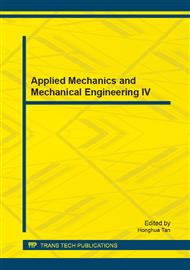[1]
A. Pennycott, D. Wyss, H. Vallery, V. K-Marganka, R. Riener, Towards more effective robotic gait training for stroke rehabilitation: a review, in: Journal of NeuroEngineering and Rehabilitation, 9: 65 (2012).
DOI: 10.1186/1743-0003-9-65
Google Scholar
[2]
N. Takeuchi, S-I. Izumi, Rehabilitation with Poststroke Motor Recovery: A Review with a Focus on Neural Plasticity, in: Stroke Research and Treatment (2013).
DOI: 10.1155/2013/128641
Google Scholar
[3]
R. Colombo, I. Sterpi, A. Mazzone, C. Delconte, F. Pisano, Taking a Lesson From Patients' Recovery Strategies to Optimize Training During Robot-Aided Rehabilitation, in: IEEE Transactions on Meural Systems and Rehabilitation Engineering, Vol. 20, nº 3 (2012).
DOI: 10.1109/tnsre.2012.2195679
Google Scholar
[4]
A. N. Kuznetsov, N. V. Rybalko, V. D. Daminov, A. R. Luft, Early Poststroke Rehabilitation Using a Robotic Tilt-Table Stepper ans Functional Electrical Stimulation, in: Stroke Research and Treatment (2013).
DOI: 10.1155/2013/946056
Google Scholar
[5]
I. Díaz, J. J. Gil, E. Sánchez, Lower-Limb Robotic Rehabilitation: Literature Review and Challenges, in: Journal of Robotics (2011).
Google Scholar
[6]
R. S. Gonçalves; J. C. M. Carvalho, Robot Modeling for Physical Rehabilitation, in: Service Robots and Robotics Design and Application. An imprint of IGI Global, pp.154-175 (2012).
DOI: 10.4018/978-1-4666-0291-5.ch009
Google Scholar
[7]
R. Rupp, H. Plewa, E.P. Hofer, M. Knestel, Motion Therapy@Home – a robotic device for automated locomotion therapy at home. In IEEE 11th Int. Conf. on Rehabilitation Robotics, Kyoto, Japan, (2009).
DOI: 10.1109/icorr.2009.5209497
Google Scholar
[8]
G. Cannella, E. Ottaviano, G. Castelli, A cable-based system for aiding elderly people in sit to stand transfer, in The Int. Symp. on Multibody Systems and Mechatronics, pp.8-12, (2008).
DOI: 10.1080/15397730802405861
Google Scholar
[9]
M. Hiller, K. Hirsch, T. Bruckmann, T. Brandt, D. Schramm, Common Aspects in Methods for the Design of Mechatronic Systems - Applications in Automotive and Robotic Systems, in XII International Symposium on Dynamic Problems of Mechanics, Angra dos Reis, RJ, (2009).
Google Scholar
[10]
A.I. Kapandji, The Physiology of the Joints, Volume 2: Lower Limb. 6th Ed., Churchill Livingstone, (2010).
Google Scholar
[11]
G. Côté, Analyse et conception de mécanismes parallèles actionnés par cables. Ph.D. dissertation, Université Laval, Quebec. (In French), (2003).
Google Scholar
[12]
J-P., Merlet, Analysis of the influence of wires interference on the workspace of wire robots, On Advances in Robot Kinematics, Kluwer Academic Publishers, pp.211-218, (2004).
DOI: 10.1007/978-1-4020-2249-4_23
Google Scholar
[13]
J. Hamedi , H. Zohoor , Kinematic modeling and workspace analysis of a spatial cable suspended robots as incompletely restrained positioning mechanism. In: World Academy of Science, Engineering and Technology: Mechanical and Aerospace Engineering, vol. 2, no. 2, (2008).
Google Scholar
[14]
J. C. M. Carvalho, A. M. Barbosa, R. S. Gonçalves, Workspace and Tension Analysis of a Cable-Based Parallel Manipulator for Lower Limb Rehabilitation: submitted and aproved to 4th International Conference on Applied Mechanics and Mechanical Engineering (2013).
Google Scholar


